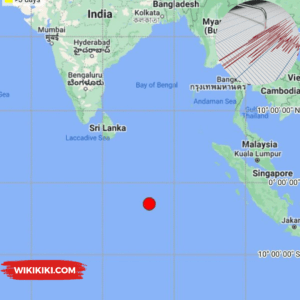On November 14, 2023, a seismic activity unfolded, leaving Sri Lanka and Ladakh, India, from dual earthquakes with magnitudes 6.2 and 4.4, respectively.

Also Read: Storm Debi: Met Office Issued Warnings in UK and Ireland
The National Center for Seismology (NCS) reported that the first earthquake, with a magnitude of 6.2, struck Sri Lanka at 12:31 p.m., originating 1326 km southeast of Colombo, in the Indian Ocean, with coordinates at -2.96 latitude and 86.54 longitude, and a depth of 10 km.
Simultaneously, a second earthquake of magnitude 4.4 hit Ladakh at 1:08 p.m., located 314 km north-northwest of Kargil, with coordinates at 37.28 latitude and 75.21 longitude, and a depth of 20 km.
The seismic activity that jolted Sri Lanka measuring 6.2 on the Richter scale. The earthquake, occurring in the Indian Ocean, had its epicenter at a distance from Colombo, approximately 1326 km southeast.
The NCS promptly reported the details on social media, stating, “Earthquake of Magnitude:6.2, Occurred on 14-11-2023, 12:31:10 IST, Lat: -2.96 & Long: 86.54, Depth: 10 Km ,Location: 1326km SE of Colombo, Sri Lanka.”
Fortunately, as of the latest updates, there have been no immediate reports of casualties, and the Geological Survey and Mines Bureau made sure that there is no danger to Sri Lanka.
In tandem with Sri Lanka’s seismic event, Ladakh experienced an earthquake of magnitude 4.4. Striking just 30 minutes after the Sri Lankan tremor, this earthquake had its own characteristics.
Also Read: Iceland Declares State Of Emergency After 800 Earthquakes Within 14 Hours
The NCS provided detailed information, stating, “Earthquake of Magnitude:4.4, Occurred on 14-11-2023, 13:08:50 IST, Lat: 37.28 & Long: 75.21, Depth: 20 Km ,Location: 314km NNW of Kargil, Ladakh, India.”
These earthquakes come on the heels of other recent seismic events around the world. On Monday, the European Mediterranean Seismological Centre (EMSC) reported a magnitude 4.9 earthquake in the border region between South Sudan and Uganda, addressing the global nature of tectonic movements.
Additionally, Tajikistan experienced a magnitude 4.9 earthquake on Monday evening, with tremors felt at a depth of 194 km. The nature of these events prompts exploration into the factors influencing seismic activities globally.
On Monday, the European Mediterranean Seismological Centre (EMSC) reported an earthquake of magnitude 4.9 in the region between South Sudan and Uganda.
The quake, with a depth of 8 km, highlights the seismic activity in various parts of the world. Tajikistan experienced a magnitude 4.9 earthquake on the same day, according to the NCS.
The tremors were felt at approximately 5:46 pm, originating at a depth of 194 km. The NCS provided detailed information about the event.
A magnitude 5.6 earthquake struck near West Timor, Indonesia, on Sunday, according to the German Research Centre for Geosciences (GFZ). The quake, with a depth of 10 km.
Also Read: Attenborough Echidna Believed Extinct Rediscovered in Indonesia
On November 11, an earthquake of magnitude 4.1 hit Pakistan, as reported by the NCS. The tremors, felt around 6:06 pm at a depth of 10 km.
On the same day, a 5-magnitude earthquake struck the northwest Dominican Republic near the border with Haiti. The US Geological Survey provided information on the location and depth of the quake.
Comparing the characteristics of the Sri Lankan and Ladakh earthquakes provides valuable insights into the nature of seismic activities.
Sri Lanka’s earthquake, with a higher magnitude of 6.2, occurred in the deep waters of the Indian Ocean, indicating a subsea fault movement. In contrast, Ladakh’s earthquake, with a magnitude of 4.4, struck closer to the surface at a depth of 20 km.
The sharing of data, research, and technological advancements can improve our collective ability to monitor, analyze, and respond to earthquakes.
Platforms like the European Mediterranean Seismological Centre and the National Center for Seismology play main roles in spreading information and collaborative efforts among nations.
Also Read: The Last 12 Month were the Hottest in 125,000 Years
























